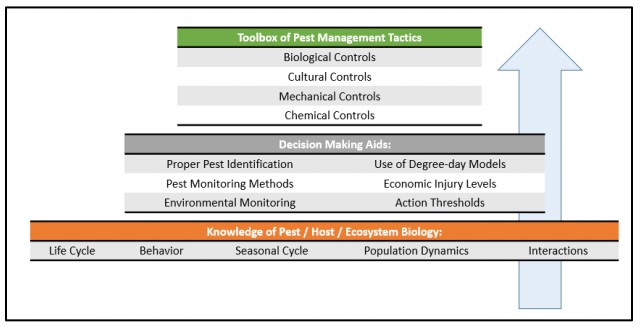An Integrated Approach to Pest Management
This summer we will discuss some of the different methods of integrated pest management, and how best to apply these to protecting fruit crops.
The whole concept of pest management took a turn in the mid-1950s. Up to that time, pest management mostly relied on synthetic chemicals, but there was a growing awareness of potential environmental and health concerns as well as problems with pests becoming resistant to pesticides (i.e. the pests were able to survive after being sprayed). From there the idea of a multi-faceted approach to pest management– Integrated Pest Management– was born.
Integrated Pest Management (IPM) is now a common form of pest control for both the large scale and backyard grower. IPM is an ecosystem-based strategy focusing on long-term reduction of pest damage through a combination of strategies. The foundation of IPM is the justified use of pesticides based on monitoring and identifying the pest and following established guidelines to reduce populations of that target organism. These methods are then combined with other forms of pest control.
Before implementing any type of plan for managing pests, it is critical to know exactly what pest(s) are present. UW-Extension offers free insect and weed identification and a plant disease diagnostic clinic that charges a small fee depending on the type of test that needs to be done. Once the pest is identified, it is important to note how many/how much of the pest there is. Plants can tolerate a certain amount of damage, so it isn’t always worth the time or money to treat for everything. Lastly, if a treatment is warranted, spending time to research the pest lifecycle to determine when the pest is most susceptible to a treatment can dictate whether the treatment works or not. The right product applied at the wrong time could have no effect.
When the time comes to choose what to do to control the pest there are a number of options. Thinking through each option BEFORE acting is foundational for IPM and regardless is likely the most effective method of pest control. There are many options, and depending on the particular pest and crop, some of these methods will work better than others. Some examples are listed below. We will go into more depth on these topics in future articles.

Some pest control options available in the IPM toolbox:
- Physical/mechanical controls: tillage, physical barriers, row covers, mulching and trapping.
- Biological controls: making the environment favorable for natural enemies of the pest or releasing natural enemies into the crop.
- Cultural controls: crop rotation when possible, sanitation (removing infested plant material), changing the timing of harvest, maintaining crop health so it can better fight off pests, and choosing disease resistant plant varieties.
- Chemical controls: using the most appropriate product that directly kills the pest or prevents its development while minimizing the impact on beneficial organisms and the environment. Make sure to carefully follow all label requirements.

